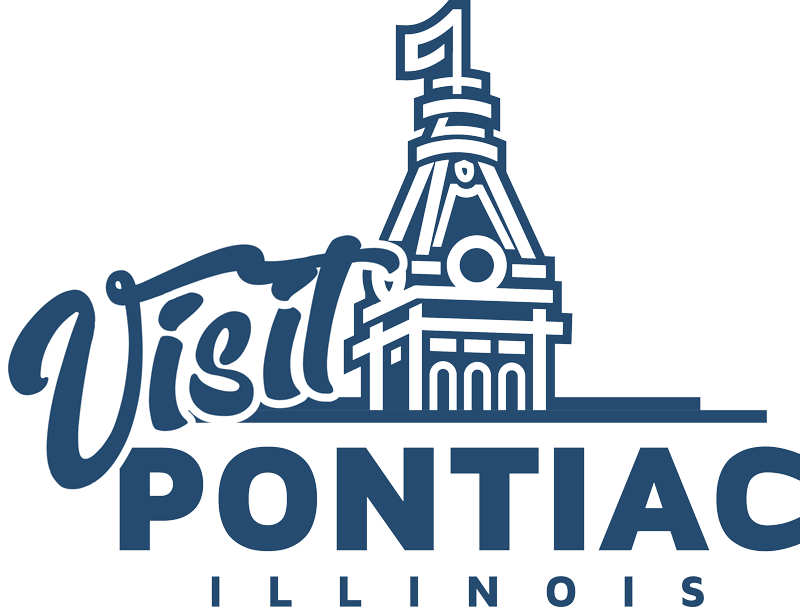Murals on Main Street
Public masterpieces
Art in Pontiac isn’t just confined to museums and galleries — it adorns our Downtown streets for all to enjoy! Pontiac is home to 24 outdoor murals that depict the city’s incredible history, including 18 Walldog Murals completed by sign painters and muralists from around the world in summer 2009. Most of the murals can be enjoyed from the comfort of your car, but a walking tour is the best way to see the many details up close!
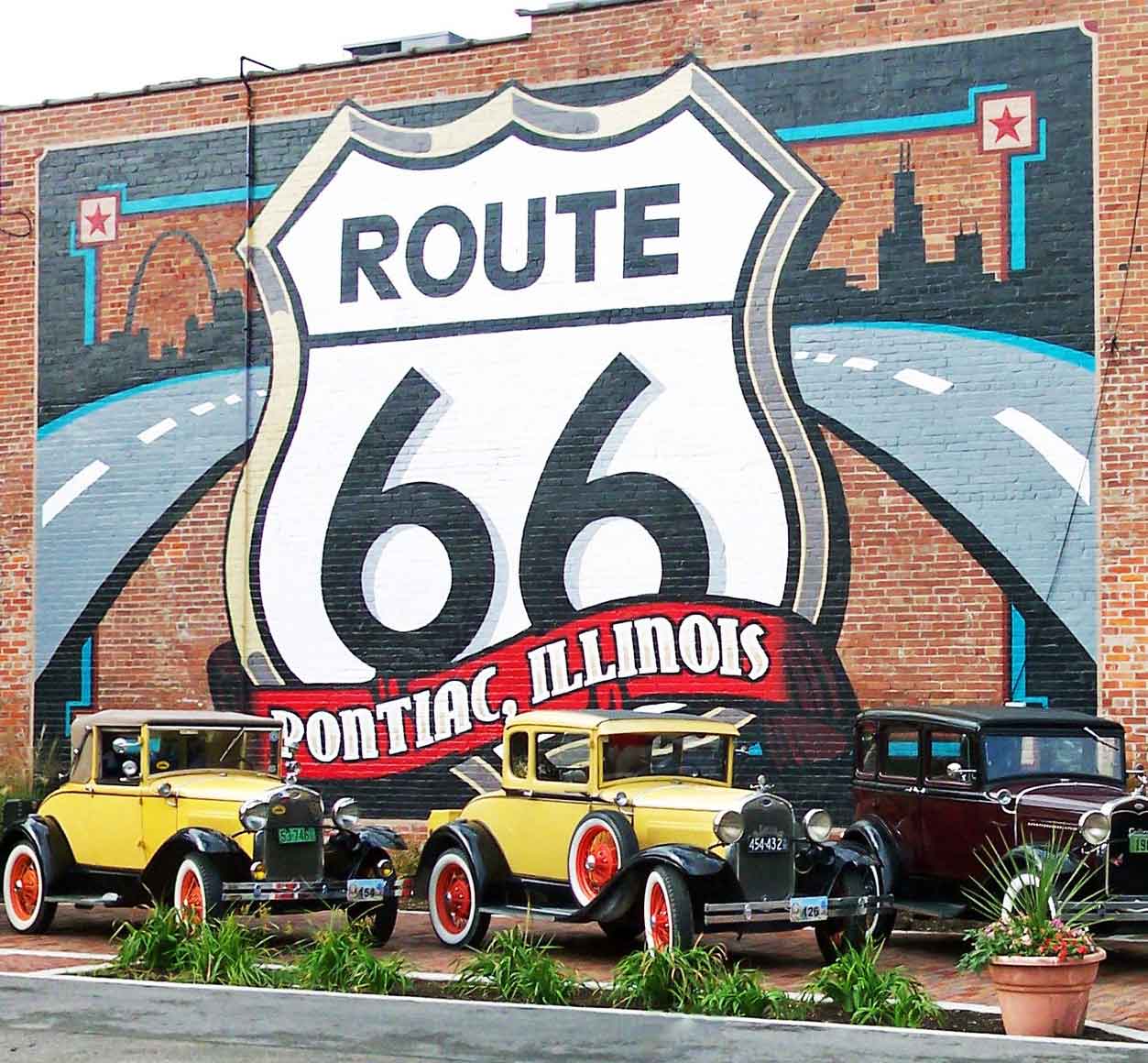
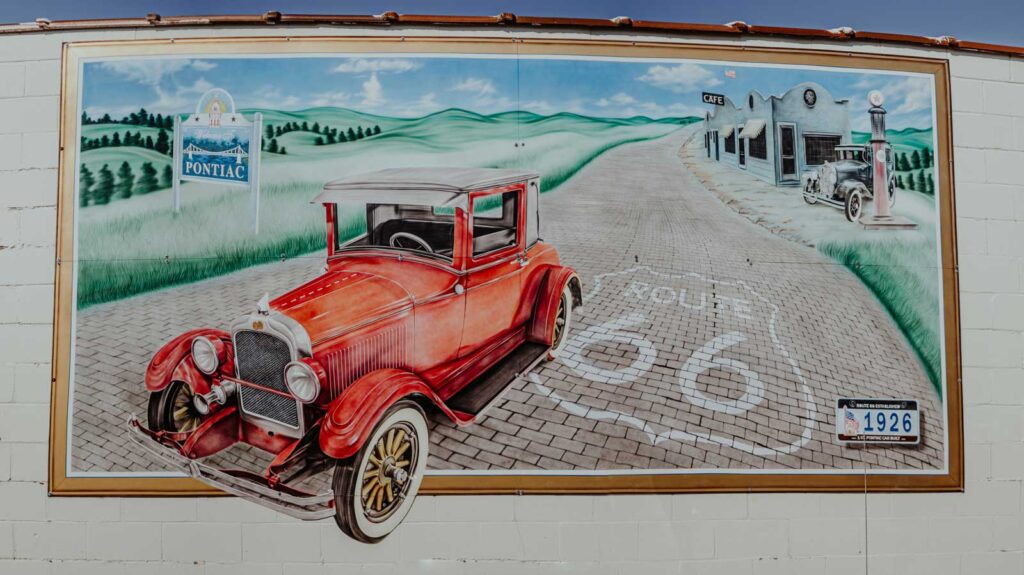
1926 Route 66 & the Pontiac Auto
1926 proved to be a profoundly impactful year for Pontiac. First was the birth of U.S. Route 66, which passed through the small town and brought economic development with it. Second, the first Pontiac automobiles rolled off the General Motors assembly line in Detroit. Both events are commemorated in this mural, displaying a 1926 Pontiac parked alongside a section of the Mother Road in Pontiac. ARTIST:
Tang Dongbai (2015). LOCATION: 423 W. Madison St. (40°52'49.2"N 88°37'56.2"W)

Allen Candy Mural
The Allen Candy Company opened in Pontiac before the turn of the century. Founder Harry Allen manufactured and sold candy of the highest quality using top-quality ingredients and hiring only the best candymakers he could find. Sometime in the 1890s, the building pictured in the mural was built on four lots at the corner of Walnut Street and Wabash Avenue. Allen Candy became famous for its Allen Nougat Bar and later the Lotta Bar, famous for its slogan “A Lotta Bar for 5 Cents.” The Allen Candy Company patent for ice cream was sold to the Meadow Gold Ice Cream Company. ARTIST: Jay Allen of Machesney Park, IL. LOCATION: 200 block of West Madison Street (40°52'48.4"N 88°37'49.8"W)
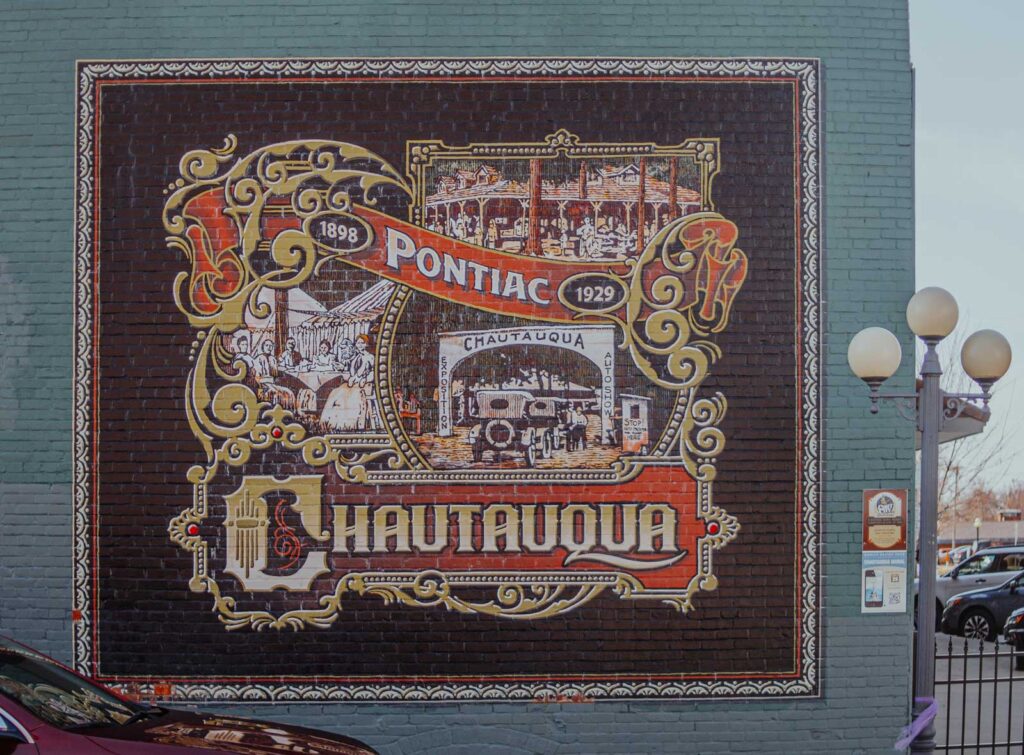
Chautauqua Assembly
Beginning in summer 1874 at Fair Point on Lake Chautauqua, the Chautauqua assemblies brought amusing cultural presentations for the entire community, featuring speakers, teachers, musicians, entertainers, preachers, and specialists. The success of the original assembly led to a movement that spread throughout the country as assemblies were organized nationwide.
The first Pontiac Chautauqua Assembly opened July 29, 1898, at Riverside Park. The 13-day event was a massive success, spawning subsequent assemblies in Pontiac and becoming one of the most exciting and comprehensive Chautauqua events for more than 30 years. ARTISTS: David and Susie Butler and Dan Sawatzky. LOCATION: 100 block of East Madison Street (40°52'49.2"N 88°37'42.7"W)
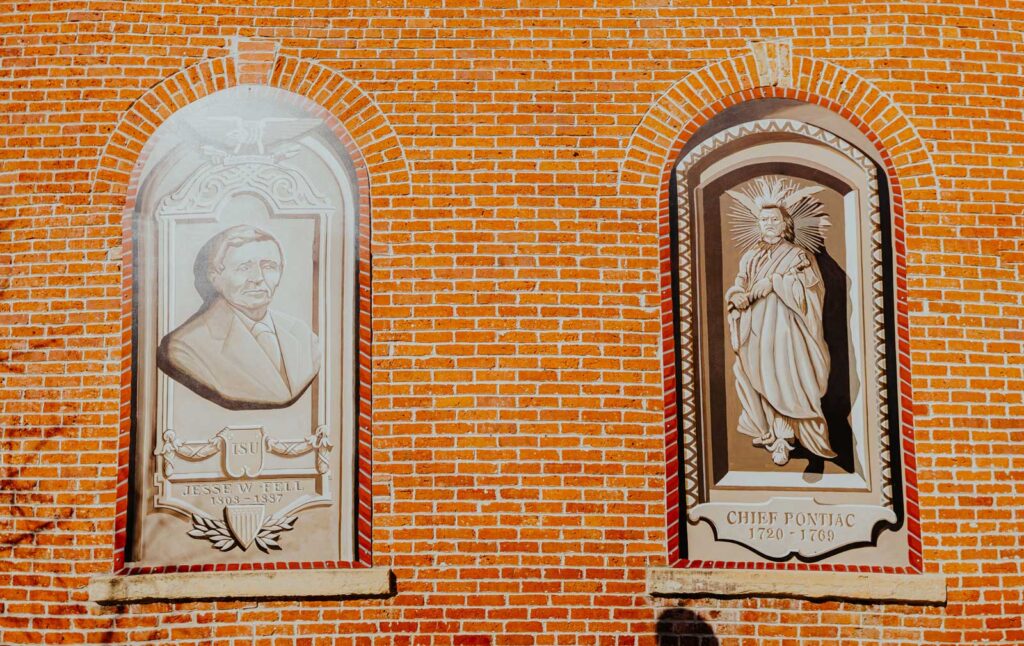
Jesse Fell & Chief Pontiac
Pontiac was founded in 1837 by Jesse Fell, a Bloomington businessman who also founded Illinois State University (then called Illinois State Normal University) in 1857. Fell named the city after the legendary Ottawa chief who was famous for his role in Pontiac’s Rebellion (1763-1766), during which Native Americans struggled against British military occupation in the lands surrounding the Great Lakes. Though no photographs or portraits survive, this mural uses a representation of Chief Pontiac based on images gathered from the Ottawa. Fun fact: During Abraham Lincoln’s 1858 Senate campaign, it was Fell who urged the lawyer from Springfield to challenge his opponent, Stephen A. Douglas, to a series of debates. ARTIST: Judy Grossman of Sonora, CA. LOCATION: 300 block of North Mill Street (40°52'49.7"N 88°37'47.6"W)

Drink Coca-Cola
Originally painted in the 1920s, a Coca-Cola advertisement once graced the same location as this newer mural. The Corsairs depicted in the mural were the same models flown by artist Sonny Franks’s father during World War II. Along with the depiction of a pilot drinking a Coke, Franks resolved to include a tribute to the nearby Livingston County War Museum and the veterans who served in the U.S. Armed Forces. In fact, the tail number featured in the foreground, 311, is a tribute to a local World War II veteran and volunteer at the War Museum. – Sonny Franks of Atlanta, GA – 300 block of North Main Street (40°52'50.3"N 88°37'43.4"W)
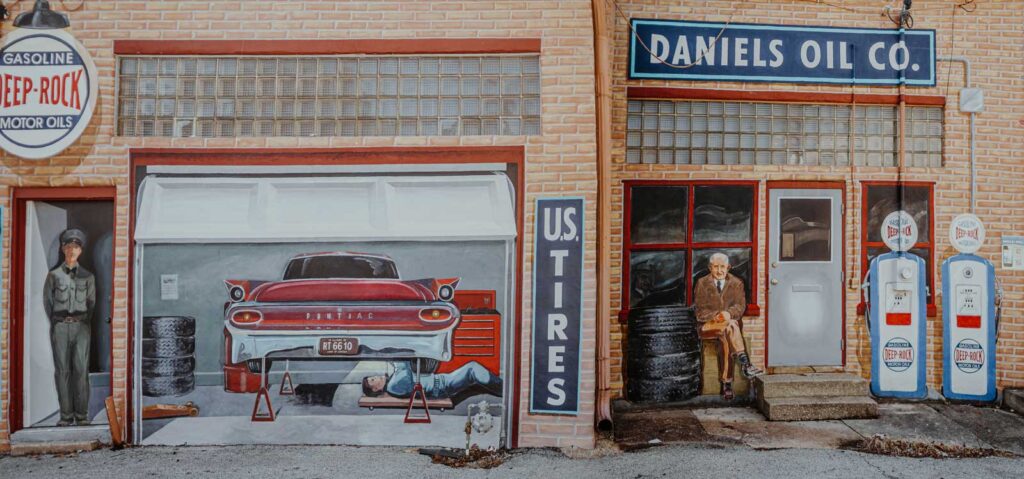
Daniels Oil
Painted on the rear exposures of two Downtown storefronts, this mural depicts the Daniels Oil gas and service station that was once located at the corner of Water and Mill streets near the Vermilion River. The painting recalls a time when gas stations provided full service to customers, simultaneously providing a place to catch up on the latest news and gossip from around the community. ARTIST:
Diaz Sign Art (summer 2010).
LOCATION: Alley in the 300 block of North Main Street (40°52'50.7"N 88°37'44.7"W)

Fire House
The history of Pontiac fire protection can be traced to June 18, 1865, with the creation of the fire prevention program, which was tasked with inspecting chimneys and flues around the city. On June 26, 1874, a hose company — later known as the Clark Hose Company — was formed. Three years later, in 1877, the Pontiac Fire Department was established consisting of 45 volunteer firefighters. Originally located on the east side of the Downtown square at Main and Washington streets, the fire station later moved to the west side of the square. Throughout the years, the fire department purchased equipment and relied on volunteers to respond to fires and emergencies. Reorganization was a common occurrence during this period. The Clark Hose Company was dissolved on July 1, 1894, later assuming a supportive role as the firefighters’ association. The department’s first chief was appointed, during which time the City of Pontiac assumed responsibility for fire protection and emergencies. Today, the City of Pontiac Fire Department responds to more than 1,500 calls per year and is served by 13 full-time members and 12 paid, on-call members. ARTIST:
Stephan Connor of Blackstone, IL. LOCATION: 200 block of West Howard Street (40°52'52.7"N 88°37'48.6"W)

Ghost Mural
Located in the back room at the Museum of the Gilding Arts, this ghost mural — a mural painted many years ago and has since faded, giving it a characteristic ghostly appearance — was discovered during renovations many years ago when some paneling was removed, uncovering what was once the exterior brick of the building next door. Because the Museum of Gilding Arts building was constructed in 1905, the mural has been dated to 1904 or earlier. The word “clothing” can be discerned in the mural, indicating the mural was an advertisement for a men’s clothing store. ARTIST: Unknown. LOCATION: The Museum of the Gilding Arts (217 N. Mill St.)

Humiston Heritage
Harriet Camp Humiston passed away on Sept. 4, 1920, leaving behind a wealth of funding stipulated in her will to be used to benefit all residents of Pontiac — not a cent to be used for religious or sectarian purposes. Since then, the Apollos Camp and Bennet Humiston Trust — named in honor of Mrs. Humiston’s father and husband who preceded her in death — has been used for various projects around Pontiac, the first being the construction of the Camp-Humiston Pool in Chautauqua Park. Other projects completed thanks to the trust include Humiston Woods Nature Center, Riverside Park, and Kiwanis-Humiston Park. ARTIST:
Gary Anderson of Bloomington, IN. LOCATION: 300 block of West Howard Street (40°52'52.9"N 88°37'52.6"W)
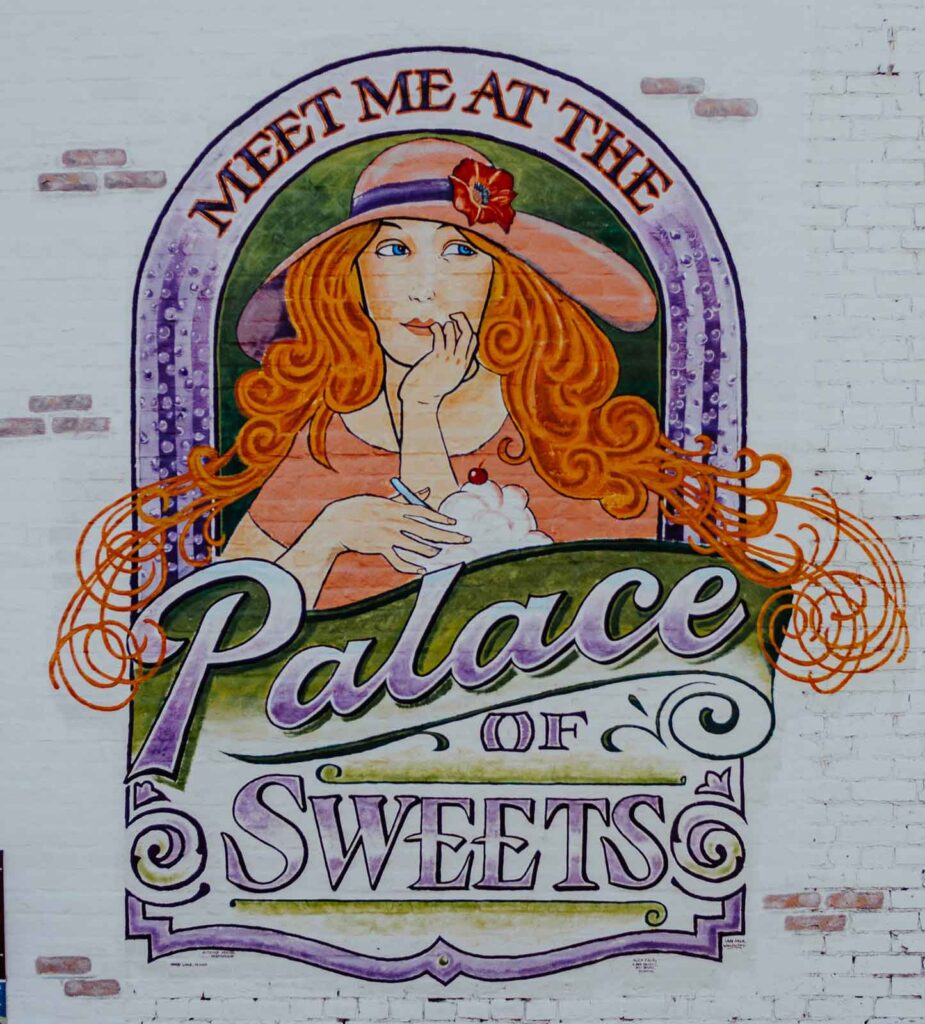
Palace of Sweets
From 1920-1930, the Palace of Sweets was a candy dreamland for all ages. Located at the corner of Madison and Mill streets, this locally famous candy store and soda fountain offered an incredible variety of tasty treats from penny candies to malts and sundaes. Among the shop’s more unique features was its gorgeous stained-glass mosaic sign on both the Madison Street and Mill Street facades — an artifact still visible today. ARTIST: Cam Bortz of Pawcatuck, CT. LOCATION:
300 block of North Main Street (40°52'50.6"N 88°37'43.6"W)
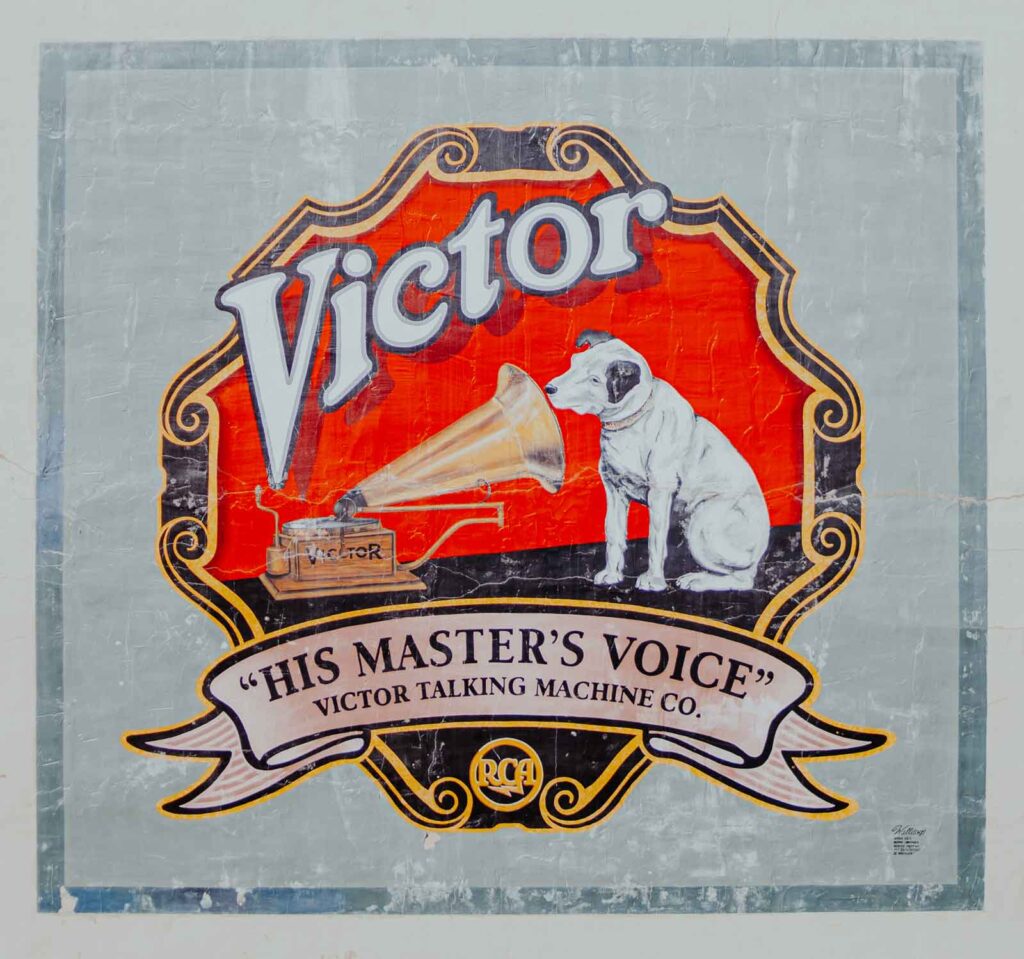
RCA Victor
Based on the 1898 painting “His Master’s Voice” by Francis Barraud, this traditional design exemplifies the efforts of the Walldogs to restore classic, outdoor signage around the world — many of which still exist as ghost murals. This brand-new version of an iconic brand pays tribute to the Walldogs of yesteryear. ARTISTS: The Triple Bernies: Bernie Gietl, a postal carrier from Carlinville, IL; Bernie Lohmeyer, a sign painter from Osage City, KS; and Bernie Poff, owner of Bernie’s Signs in Prairie Du Sac, WI. LOCATION: 200 block of West Howard Street (40°52'51.6"N 88°37'49.4"W)
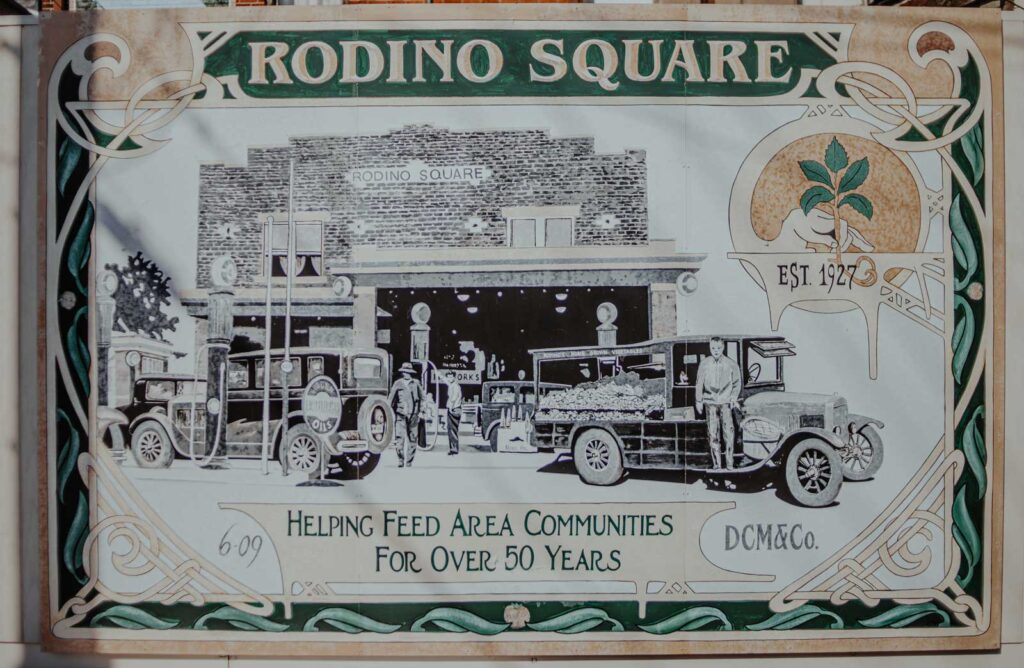
Rodino Square
Built in 1927 by Carmen Rodino as a full-service stop with a grocery and liquor store, hotel, restaurant, tavern, and gas and automobile station, Rodino Square was situated on a portion of road that would eventually become Route 66. Rodino, along with his wife and six children, planted large vegetable gardens each year, making Rodino Square a popular destination for fresh produce. Additionally, Rodino drove his Model T around town and sold vegetables from the bed of his truck, announcing his presence with two loud blasts from his truck’s horn. Rodino drove the route into the 1960s, and the store closed in 1978. ARTIST: Dale Manor, a model maker at Waterloo Industries in Oak Creek, WI. LOCATION: 300 block of North Main Street (40°52'50.8"N 88°37'45.3"W)
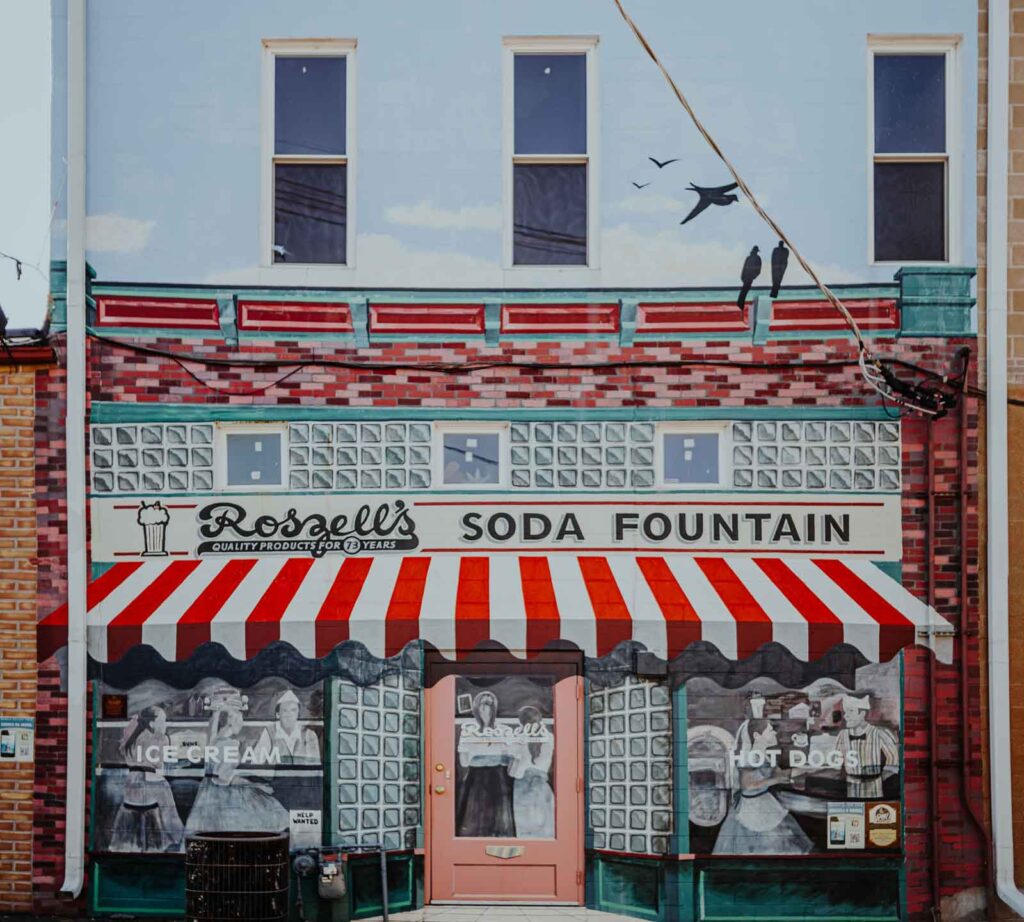
Roszell’s Soda Shop
Although this mural is a fictional representation, it represents an era when soda fountains were common staples in nearly every American small town. The name of the soda shop depicted, “Roszell’s,” was also the name of a Pontiac dairy that operated around the turn of the century. ARTIST: Joe Diaz of Pontiac.
LOCATION: 300 block of North Main Street (40°52'50.6"N 88°37'45.1"W)
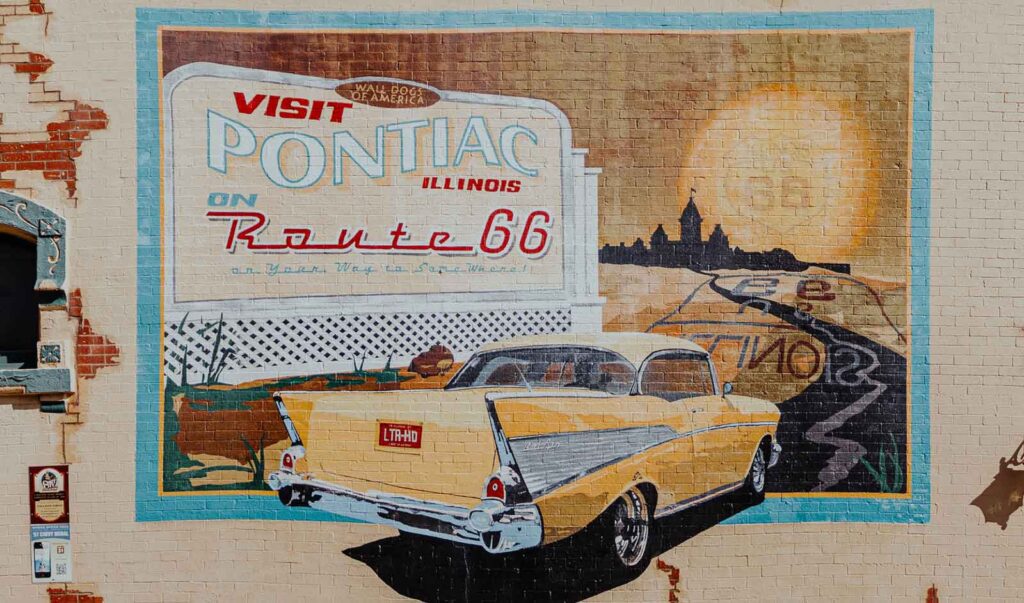
Pontiac on Route 66
Route 66 is the most well-known highway in the United States — and perhaps the world. Commissioned in 1926 with the rest of the federal highway system, it carried transcontinental travelers from Chicago to Santa Monica until it was decommissioned in 1985, having been replaced by the Interstate Highway System decades earlier. In its nearly 60 years of existence, however, the Mother Road earned a home in the hearts and memories of those pilgrims who traveled the storied road. Passing through eight states — Illinois, Missouri, Kansas, Oklahoma, Texas, New Mexico, Arizona, and California — the Land of Lincoln was the first to have its section completely hard surfaced and was the first to replace it with the new interstate. Today, Pontiac is home to the Route 66 Association of Illinois Hall of Fame & Museum. ARTISTS: Tom and Kathy Durham of St. Louis, MO. LOCATION: 200 block of West Washington Street (40°52'46.6"N 88°37'48.0"W)
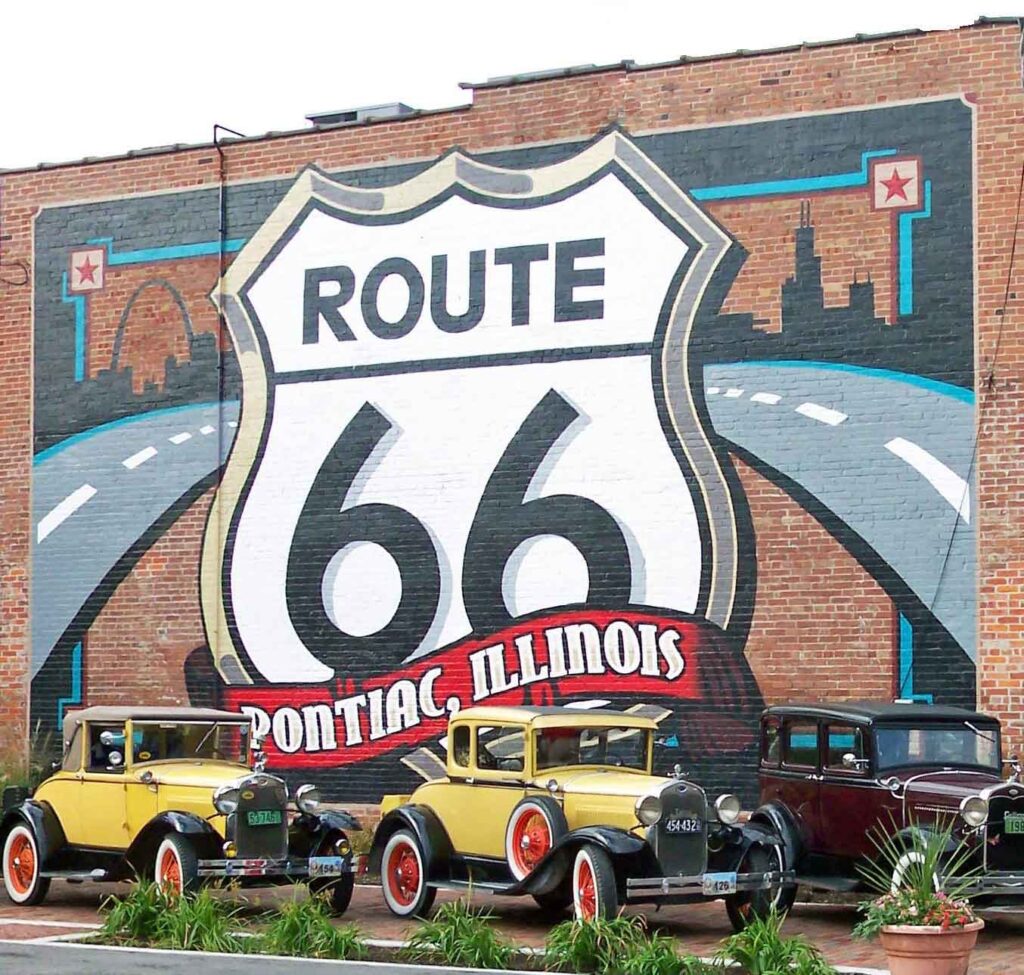
Route 66 Shield
Our oldest and most famous mural, the Route 66 Shield Mural was painted in 2006 by the incredible, talented artists from Diaz Sign Art on the outside back wall of the Route 66 Hall of Fame & Museum. In front of the mural, original Route 66 bricks provide a space for visitors to park their cars, trucks, or motorcycles for a one-of-a-kind photo op; vehicle access is located on the 300 block of North Main Street. ARTIST:
Designed and painted by Diaz Sign Art of Pontiac. LOCATION:
Route 66 Hall of Fame & Museum (110 W. Howard St.)

Scatterday’s Soda
H.H. Scatterday owned Scatterday Inc., a local bottling company located on four lots he purchased for $800 in November 1881. In 1886, his business had grown so much he was able to build a new brick factory on his residence grounds in the 500 block of East Water Street. Sometime before 1920, the business was moved to an even bigger space in the 500 block of West Cleary Street. The Scatterday Soda Water Manufacturing Works produced carbonated beverages in the early 20th century. They also opened the Scatterday Soda Water store in 1901 on the corner of Division and Water streets. ARTIST: Carole Bersin.
LOCATION: 312 N. Mill St. (40°52'50.6"N 88°37'46.8"W)
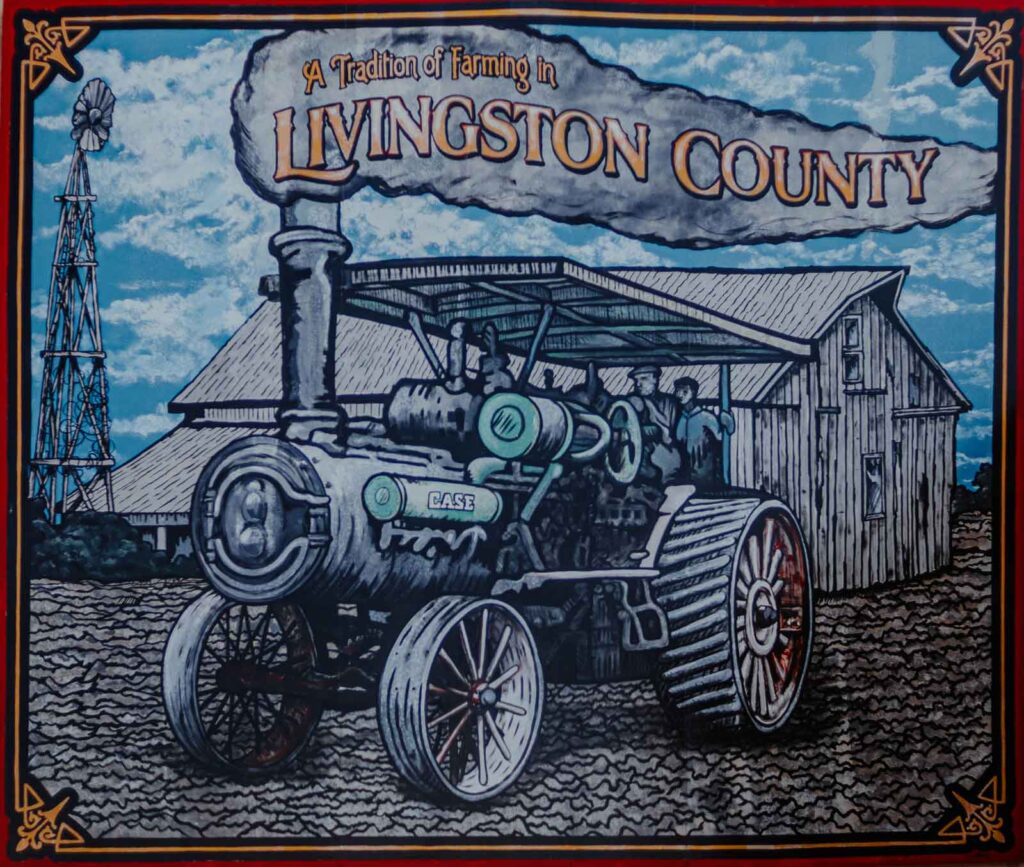
Tradition of Farming
Farming has always been the economic backbone of Pontiac and the surrounding towns in Livingston County. Every Labor Day week, Pontiac hosts the Central States Threshermen’s Reunion, an annual event since 1949. This mural celebrates the farming roots of the area as well as the steam-powered machines that were among the first steps in moving agriculture into the modern age. ARTIST: Michael Clark, formerly of Aleda, IL. LOCATION: 218 W. Howard St. (40°52'51.9"N 88°37'50.2"W)

Vermillion River
The Vermilion River flows north from its origin in Livingston and Ford counties, eventually emptying into the Illinois River near Oglesby. At one point in the history of Pontiac, the Vermillion River powered five different mills in the city, including three grist mills, a lumber mill, and a wool mill. The building depicted on the right of the mural was known as the Williams’ Mill. Built sometime before the Civil War, the mill operated until fire destroyed the interior in 1955. It was demolished in 1957. The Swinging Bridge pictured on the left is another distinguishing feature of Pontiac. The first two bridges were built in the early 1900s to carry workers from the south side of town to factories on the north side. The third bridge was finished in 1980 strictly for recreational and aesthetic value. ARTIST: Francisco Vargas. LOCATION:
200 block of West Water Street (40°52'41.6"N 88°37'48.5"W)
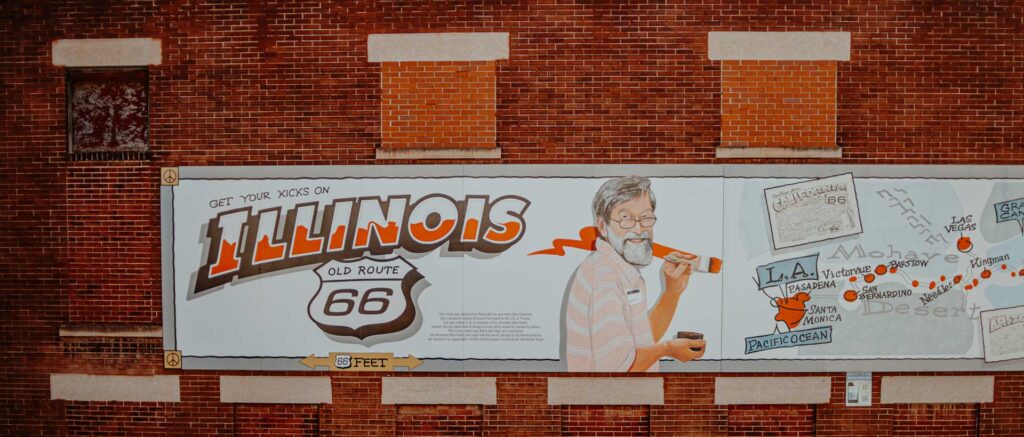
Waldmire Memorial
Completed in May 2011, this appropriately 66-foot mural features a map of Route 66 and was designed by Bob Waldmire from his sickbed just a short time before he passed away in 2009. It was painted in Bob’s memory by members of the Waldmire family and about 500 of Waldmire’s friends from along the Mother Road. If you stand close to the mural, you’ll notice hundreds of handprints — everyone who worked on his mural and who felt they had been touched by his art left a handprint. ARTIST: Bob Waldmire, Route 66 artist and icon. LOCATION:
300 block of North Main Street (40°52'50.0"N 88°37'43.1"W)
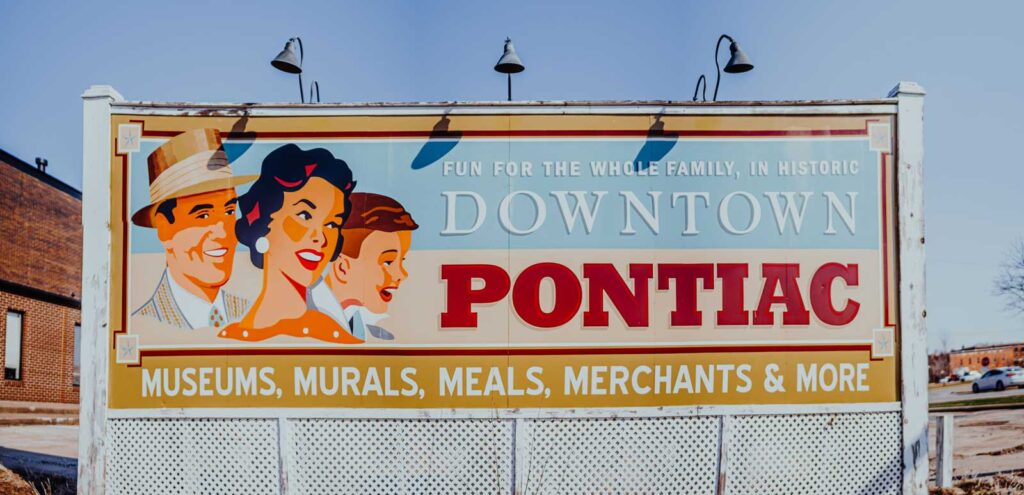
Welcome to Downtown
Painted on the reverse side of the Vermilion River & Old Mill mural, this mural welcoming travelers to Downtown depicts a mid-20th century family while promoting the many attractions around Pontiac such as museums, murals, dining, and shopping. ARTIST: Diaz Sign Art.
LOCATION: 200 block of West Water Street (40°52'41.6"N 88°37'48.5"W)
